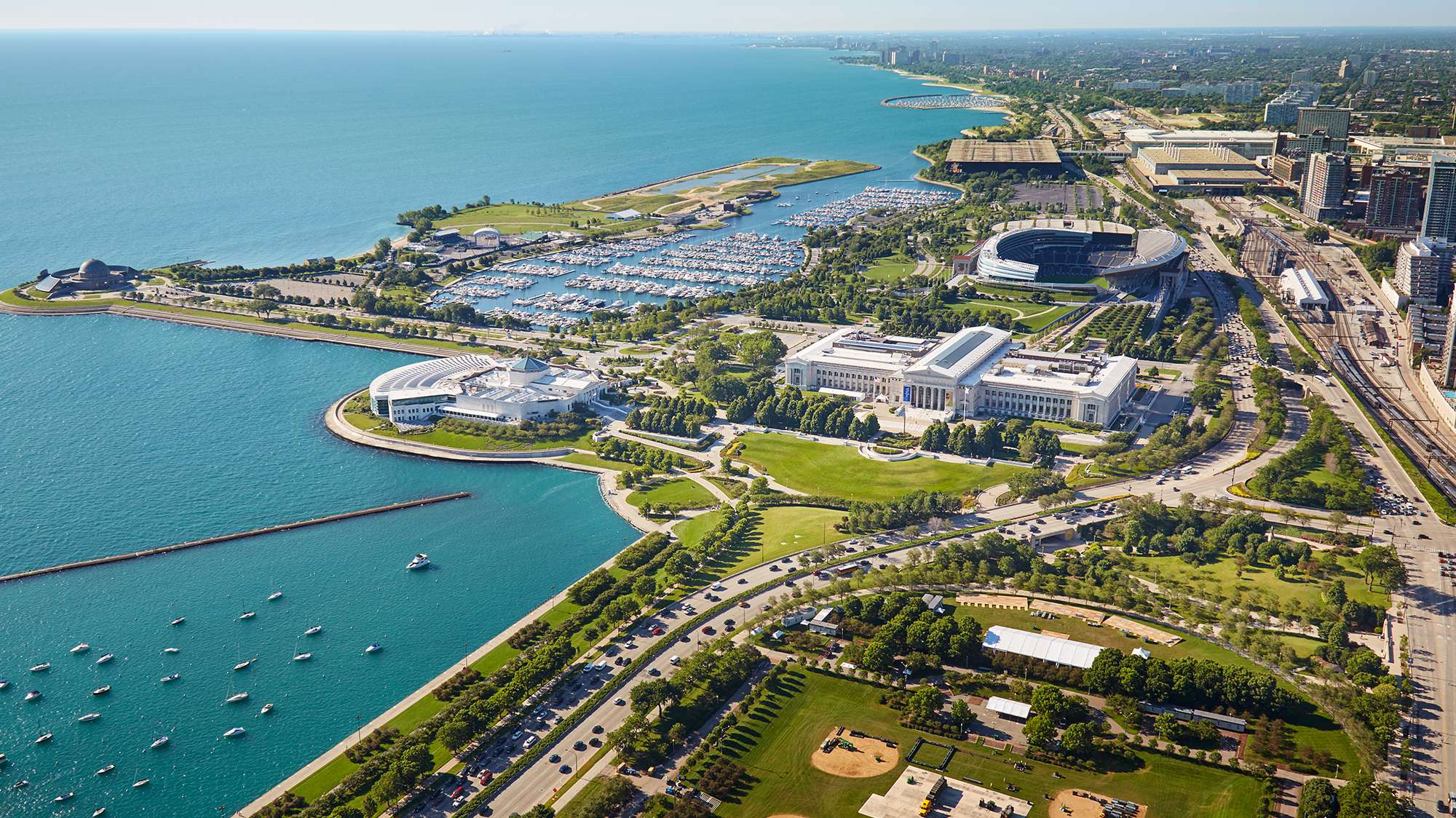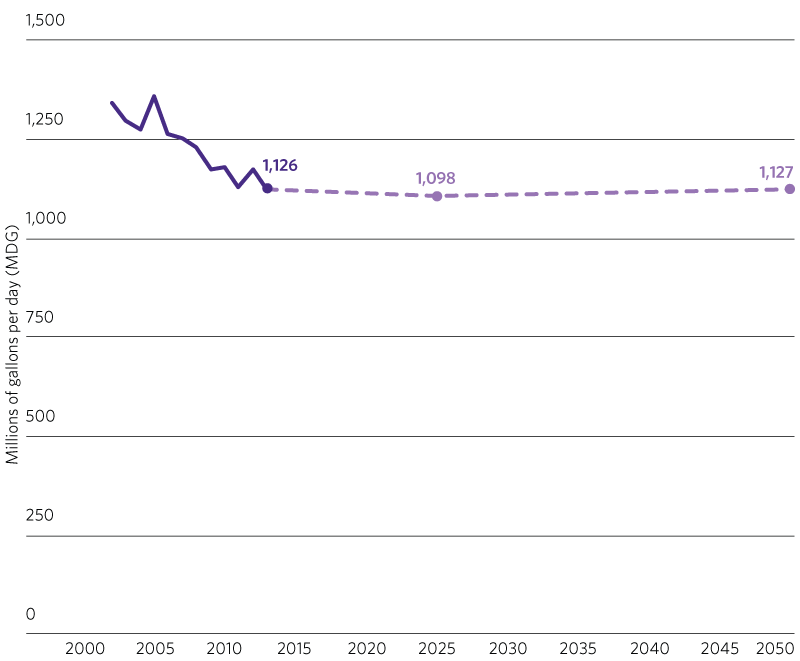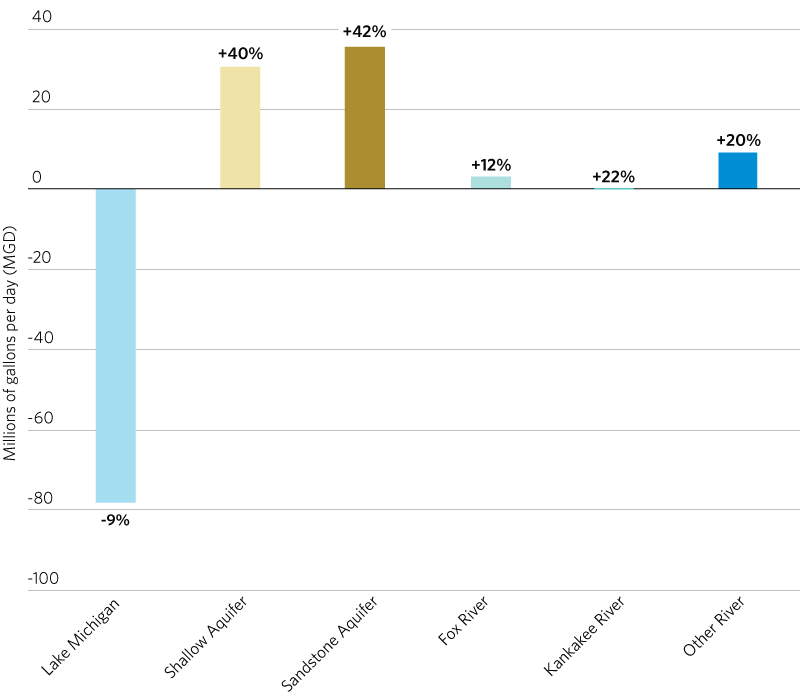Recommendation
Coordinate and conserve shared water supply resources

Water resources are essential for sustaining economic prosperity, environmental and public health, and quality of life in the region. The leading sources of water in the region are Lake Michigan, groundwater aquifers, and the Fox and Kankakee Rivers. Access to Lake Michigan water has been critical to regional development and, if well managed, will continue to provide a sustainable supply of water into the future for much of the region. Illinois withdraws, uses, and then diverts Lake Michigan water out of the Great Lakes Basin to the Mississippi River system, a modification which resulted in a U.S. Supreme Court Consent Decree that governs Illinois withdrawal of lake water, which is managed by the IDNR. Over the years, access to Lake Michigan water has been extended, providing a more sustainable drinking water source. That said, there are limits to the amount of water the state can withdraw, which may limit some communities’ ability to access Lake Michigan water.
CMAP has updated the regional water demand forecast to reflect recent trends and the ON TO 2050 Socioeconomic Forecast. Overall water use is estimated to be relatively stable as the amount of water used per resident or per employee is anticipated to continue to decline. However, long-term sustainability of the region’s future water supply depends on the geographical distribution of demand and which water sources are supplying the water.
Strategies
- Recent withdrawals
- Projected withdrawals
Note: Even with more residents and jobs, water demand is anticipated to be relatively stable due to conservation and efficiency. Forecast includes withdrawals from public water supplies, industrial and commercial self-supply wells, and domestic self-supply wells.

Population growth and industrial development, particularly in the collar counties, has led to increasing withdrawals from constrained groundwater resources. Continued use of groundwater sources will require coordinated management throughout the region in the future, especially during droughts. In some areas, groundwater is being withdrawn at a rate that exceeds the recharge rate, resulting in decreasing yields, increasing pumping demands, increasing salinity, and the search for alternative water sources, all of which increase the cost of providing water. For example, increasing withdrawals from community water suppliers as well as industrial users in western Will County and northern Kendall County are posing significant risks to the existing quantity and quality of water supply as portions of the aquifer become desaturated. Similarly, shallow aquifer withdrawals in northeastern Kane County and southeastern McHenry County are exceeding the recharge rate, which may result in neighboring wells competing for less water and impacts to nearby streams and rivers dependent on groundwater flows. Land use and transportation decisions affect the amount of water that's available to replenish shallow aquifers as well as the quality of the water that enters our groundwater reservoirs. For example, roads and conventional road and parking lot salting practices are linked to rapidly rising chloride levels in some parts of the region. Water supply management will help to maintain water supplies, support community livability, and mitigate potential conflicts arising from water shortages.
Note: Demand could outstrip supply in critical areas. From 2011-50, demand projections may not be supported by some aquifers given that current withdrawals already exceed sustainable rates.


Community water suppliers -- consisting of municipalities, sub-regional authorities, and private companies -- provide an essential service and are key to the region's economic success. They must maintain safe, efficient infrastructure at affordable prices while also managing water use to ensure a long-term supply. This challenging task is often exacerbated by aging infrastructure and strained financial capacity. Mounting infrastructure repair can result in high levels of water loss and delays in replacing lead and copper infrastructure. Some suppliers must also address large shifts in demand, such as new development or the closing of major industries, while others make long-term decisions in the face of near-term supply uncertainties. In addition, local elected officials and residents can be unfamiliar with the complexity of our water supply and the day-to-day challenges faced in continuing to provide clean, safe and reliable water. Low income residents, people of color, and the elderly may be disproportionately affected by deferred maintenance, replacement, and service costs, which are eventually passed on to consumers. To maintain our quality of life and economic competitiveness, the region should pursue strategies that maintain and improve drinking water infrastructure and protect water sources.

The following subsection describes strategies and actions to implement this recommendation.
Incorporate water supply and demand considerations into local and regional planning
Understanding both the available supply of water and the current and future demand is critical to making informed land use, transportation, and infrastructure investment decisions. Today several different state agencies collect and analyze information about the use and condition of our region’s drinking water supply, which can result in redundancy and gaps in planning and responsibilities. A properly funded and coordinated approach could enhance regional understanding of and planning for water supply and demand.
Working together, land use planners and water utility managers can align local planning efforts with current and future water supply constraints. Assessing forecasted demand scenarios in the context of available water supply and infrastructure capacity can inform regional and local planners about the sufficiency of water supply and encourage actions that conserve water, protect supply, and/or pursue alternative drinking water sources. In particular, local water demand forecasts can help bridge land use, transportation, and municipal finance and asset management decisions as development patterns affect water use and also long-term infrastructure maintenance costs. Avoiding expensive capacity expansions can help maintain municipal fiscal stability but requires coordination across municipal departments to reduce water demand.
Coordinate community water supplier reporting requirements and improve data sharing across agencies and partners.
The State
Fund critical surface and groundwater supply research and expand groundwater quality and quantity monitoring.
The U.S. Geological Survey, State, and Counties
Regularly update the regional water demand forecast in conjunction with socioeconomic forecast updates and incorporate projected impacts of climate change.
CMAP
Conduct local water demand forecasts and integrate demand management and conservation strategies in land use and infrastructure planning efforts.
Local governments and other community water suppliers
Protect the quantity and quality of water supply sources through open space and recharge area protection, as well as other water pollution control measures.
Local governments
Provide technical assistance to communities to incorporate water supply and demand management strategies in local plans, ordinances, and development review processes.
CMAP and partners
Consider long-term water availability and infrastructure costs in decisions about large scale water users and the expansion of drinking water services in new development.
Local governments
Research and develop a process to evaluate, avoid, and minimize the direct and indirect water resource impacts of regionally significant transportation projects and of the development they induce in locations facing water supply constraints.
CMAP, local governments, and transportation agencies
Strengthen regional water supply management
Illinois groundwater withdrawals are governed under the rule of reasonable use, with no permitting program for withdrawals. Building on the precedent of the Lake Michigan Allocation program, CMAP supports the development of a comprehensive groundwater management program to resolve conflicts and manage withdrawals for long-term sustainability. This will be particularly important in coming years as climate change is expected to diminish the amount and quality of water supplies while also increasing water demand. To implement such a program, critical elements of water supply management will need to be strengthened, including more robust annual and monthly water reporting from communities, to inform the regional groundwater flow model, river water studies, and regional water demand forecast. Communities that coordinate with ISWS to review new public or private well proposals will have a better understanding of potential effects and can plan accordingly to reduce conflicts and shortages.
Communities are already organizing to protect water resources, with examples that include the Northwest Water Planning Alliance (NWPA), the Barrington Area Council of Governments, and communities and industrial partners in the Joliet area. As groundwater is a shared regional resource, withdrawals require coordination across jurisdictions; management systems can evolve as new information and policies become available. As groundwater-dependent communities face growing challenges due to over-withdrawal and contamination, some might pursue access to Lake Michigan water. As required by their permits, Lake Michigan communities can help make more of the state’s limited allocation available to others in the region by increasing conservation and efficiency and reducing water loss. Water 2050 and a subsequent CMAP report identified key strategies for water demand management and water loss reduction.
Continue to disseminate information to groundwater-dependent communities on the potential effects of continued groundwater withdrawals and consequences for existing communities and future growth.
Regularly report water use to the State and consult ISWS on groundwater impacts of new development and wells.
Community water suppliers
Explore ways to coordinate withdrawals and management of shared water resources with neighbors.
Community water suppliers, dependent on constrained supplies
Continue local and sub-regional coordination efforts, promote demand management strategies, and explore the development of plans for existing and future Fox and Kankakee River users.
CMAP, NWPA, and partners
Explore the development of a comprehensive groundwater management program.
CMAP and partners
Explore and advance specific legislative changes of the state-wide groundwater protection authority as part of a larger effort to improve state management of water resources.
IDNR and the State Water Task Force
Follow the Lake Michigan Allocation Program requirements to maintain compliance with provisions of the U.S. Supreme Court consent decree and the Great Lakes Compact.
Lake Michigan permittees
Promote stormwater infiltration to reduce the amount of stormwater runoff that counts toward the allowable allocation.
Local governments, within the Lake Michigan basin
Develop contingency plans for droughts and other water emergencies that limit the availability of water.
Municipalities, working with counties and state partners
Maintain drinking water infrastructure and manage demand
Investing in long-term maintenance of drinking water systems is an ongoing challenge for many communities. Because water infrastructure is largely an underground asset, its maintenance needs are not as apparent as other community challenges. Addressing deferred maintenance and modernization -- such as lead mitigation -- can require substantial funding, and as the region’s infrastructure ages and faces increasing impacts from climate change, maintenance needs are anticipated to grow. CMAP supports state efforts to make the Public Water Supply Loan Program more accessible for communities and encourages the prioritization of projects based on realistic water demand projections and maintenance of existing water capacity before new capacity investments.
Managing water demand is another way community water suppliers can avoid expensive new expansion projects and focus on maintenance of existing assets. As outlined in Water 2050, foundational demand management strategies include annual water loss audits, full-cost pricing to set appropriate water rates based on infrastructure need, water reuse and conservation programs, and universal metering to accurately account and charge for water usage. For more information on full-cost pricing, see the Local governments should implement user fees strategy. Municipalities across the region are also updating ordinances and educating customers about conservation and efficiency in landscaping and watering.
Water affordability is a growing concern in many communities as continuing escalation of service and infrastructure costs translate into rising utility bills. Areas with vulnerable populations, such as low income residents, people of color, and the elderly, are disproportionately affected. Water pricing should be sensitive to the ability of the consumer to pay, yet small utilities with a low income customer base may struggle to achieve the appropriate rate structure that pays for the system. Water utility consolidation is one strategy to address these challenges. The Chicago region has hundreds of community water supply systems, most of which are publicly owned and managed by a municipality. Small water suppliers are more likely to face significant capital constraints for maintenance and upgrades and often struggle to meet state standards. Communities are already exploring ways to gain efficiencies of scale through collaboration and consolidation, and they should continue to investigate potential options among neighboring utilities.
Implement asset management and water demand management strategies.
Community water suppliers
Utilize the IEPA Public Water Supply Loan Program for low interest loans.
Community water suppliers
Continue asset management and water demand management training and support for community water suppliers.
IEPA and partners
Continue to advance water conservation, efficiency, and reuse standards in plumbing fixtures and appliances.
U.S. EPA and the State
Ensure safe, clean, abundant, and affordable water, and evaluate and address affordability impacts of rate increases on low income customers.
Community water suppliers
Target assistance to communities facing high maintenance needs and water affordability challenges.
Work with nearby water suppliers to explore costs and benefits of service sharing and utility consolidation.
Community water suppliers, particularly those contemplating alternative water sources or large-scale capacity changes